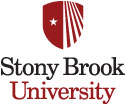 |
Stony Brook Center for Nuclear Theory / Nuclear Theory Group |
 Nuclear Theory Group |
The Cookies We CrumbleNonperturbative Quantum ChromodynamicsQuantum Chromodynamics (QCD) is the fundamental theory of strong interactions. We are mainly interested to study QCD in its nonperturbative domain, in which various topological objects -- instantons, sphalerons, dyons, monopoles, vortices -- are operating. We are also working on nucleons as topological soliton made of the mesonic fields, called the skyrmions. QCD at finite temperature and densityA variety of approaches which respect the fundamental QCD phase transitions have been constructed and applied. Those include chiral symmetry restoration and deconfinement. These studies, which include effective Lagrangians and random matrix theory, permit detailed comparison with and interpretations of the results of lattice gauge simulations. QCD correlation functions permit the extension of predictions for the modification of hadronic properties at high temperature and density. We are also interested in strongly coupled regime of the Quark-Gluon Plasma, which we study using topological solitons as well as the so called AdS/CFT correspondence. In the latter such plasma is dual to certain black holes, and the correlation functions are calculated in curved space. Physics of Heavy Ion CollisionsRelativistic Heavy Ion Physics is the study of nucleus-nucleus collisions at high energies in order to understand the behavior of extended nuclear matter under the extreme conditions of high density and temperature. The primary goal is to reach the phase transition from ordinary nuclear matter to a quark-gluon plasma: those experiments are done at Relativistic Heavy Ion Collider (RHIC) at Brookhaven and Large Hadron Collider (LHC) at CERN. Heavy Ion Collisions will further our understanding of the creation of the universe, because they probe similar conditions as shortly after the Big Bang. This field of research offers the only means to study the fundamental theory of strong interactions in the high density limit and to observe directly the parameters of the predicted phase transition. Relativistic collisions of heavy ions may also provide the information on the equation of state of nuclear matter at densities relevant to the interior of neutron stars. Manybody PhysicsOur group is traditionally interested in various studies of quantum many-body systems. The major object is of course nuclear matter and nuclei. Accurate effective nucleon-nucleon and hyperon-nucleon interactions are being constructed, using the renormalization group methods, for purposes of performing nuclear structure calculations. But we also study many more systems, in particular plasmas and strongly coupled trapped bosonic and fermionic atoms. The latter happen to compete with strongly coupled QGP for the role of "the most perfect liquid" View the research highlights & most quoted NTG papers |
| View the research highlights & most quoted NTG papers | |